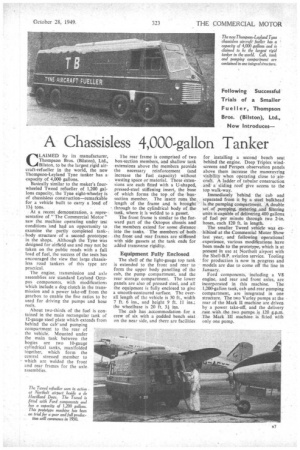A. 4,000-gallon Tanker C LA1MED by its manufacturer, Thompson Bras. (Bilston),
Page 41

If you've noticed an error in this article please click here to report it so we can fix it.
Ltd., Bilston, to be the largest rigid aircraft-refueller in the world, the new Thompson-Leyland Tyne tanker has a capacity of 4,000 gallons.
Basically similar to the maker's fourwheeled Tweed refueller of 1,200 gallons capacity, the Tyne eight-wheeler is of chassisless construction—remarkable for a vehicle built to carry a load of 134 tons. , .
At a recent demonstration, a representative of "The Commercial Motor" saw the machine operating under test conditions and had an opportunity to examine the partly completed tank-1 . body structure of a second prototype . in the shops. Although the Tyne was designed for airfield use and may not be taken on the public roads with a full load of fuel, the success of the tests has encouraged the view that large chassisless road tankers of this type are practical.
The engine, transmission and axle assemblies are standard Leyland Octopus components, with modifications which include a dog clutch in the transmission and a power take-off from the gearbox to enable the five ratios to be used for driving the pumps and hose reels.
About two-thirds of the fuel is contained in the main rectangular tank of 12-gauge steel plate which extends from behind the cab' and pumping compartment to the rear of the vehicle. Mounted under the main tank between the bogies are two 10-gauge cylindrical tanks, man ifolded together, which form the central stressed member to which are welded the front and rear frames for the axle. assemblies. Ihe rear frame is comprised of two box-section members, and shallow tank extensions above the members provide the necessary reinforcement (and increase the fuel capacity) without wasting space or material. These extensions are each fitted with a U-shaped, pressed-steel stiffening insert, the base of which forms the top of the box
section member. The insert runs the length of the frame and is brought through to the cylindrical body of the tank, where it is welded to a gusset.
The front frame is similar to the forward part of the Octopus chassis and the members extend for some distance into the tanks. The members of both the front and rear frames are stiffened with side gussets at the tank ends for added transverse rigidity.
Equipment Fully Enclosed
The shell of the light-gauge top tank is extended to the front and rear• to form the upper body panelling of the cab, the pump compartment, and the rear storage compartment. The lower panels are also of pressed steel, and all the equipment is fully enclosed to give a smooth-contoured surface. The overall length of the vehicle is 30 ft., width 7 ft. 6 ins., and height 9 ft. 11 ins.; the wheelbase is 20 ft, 3i ins.
The cab has accommodation for a crew of six with a padded bench seat on the near side, and there are facilities for installing a second bench seat behind the engine. Deep Triplex windscreens and Perspex observation panels above them increase the marueuvring visibility when operating close to aircraft. A ladder of tubular construction and a sliding roof give access to the top walk-way.
Immediately behind the cab and separated from it by a steel bulkhead is the pumping compartment. A double set of pumping, metering and filtering units is capable of delivering 400 gallons of fuel per minute through two 2-in. hoses, each 120 ft. in length.
The smaller Tweed vehicle was exhibited at the Commercial Motor Show last year, and following operational experience, various modifications have been made to the prototype, which is at present in use at Northolt airport with the Shell-B.P. aviation service. Tooling for production is now in progress and models are due to come off the line in January.
Ford components, including a V8 engine, and rear and front axles, are incorporated in this machine. The 1,200-gallon tank, cab and rear pumping compartment, are integrated in one structure. The two Varley pumps at the rear of the Mark II machine are driven by a power take-off, and the delivery rate with the two pumps is 120 g.p.m. The Mark III machine is fitted with only one pump.




























































































